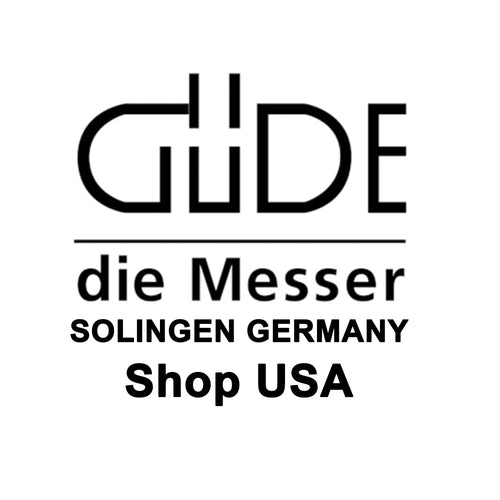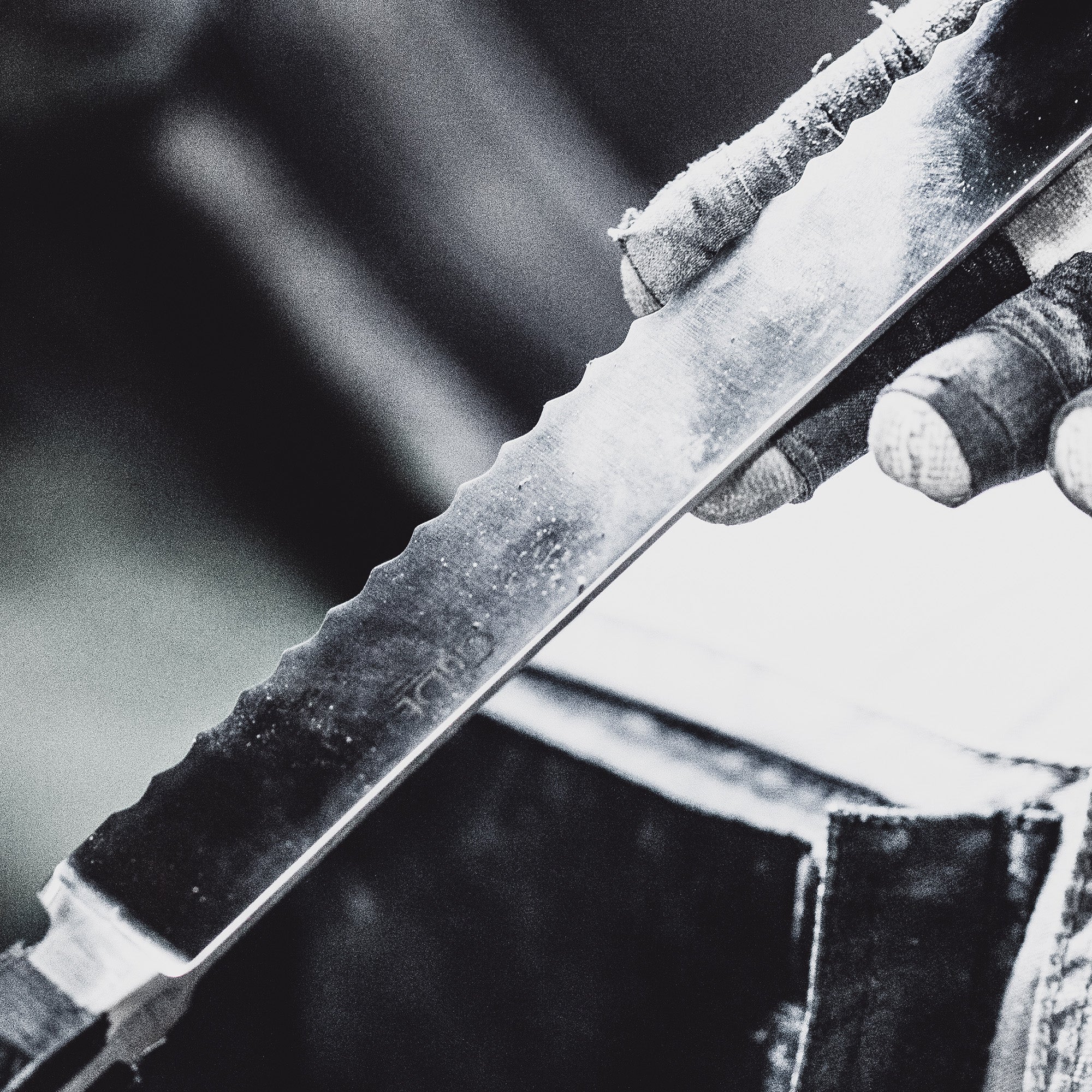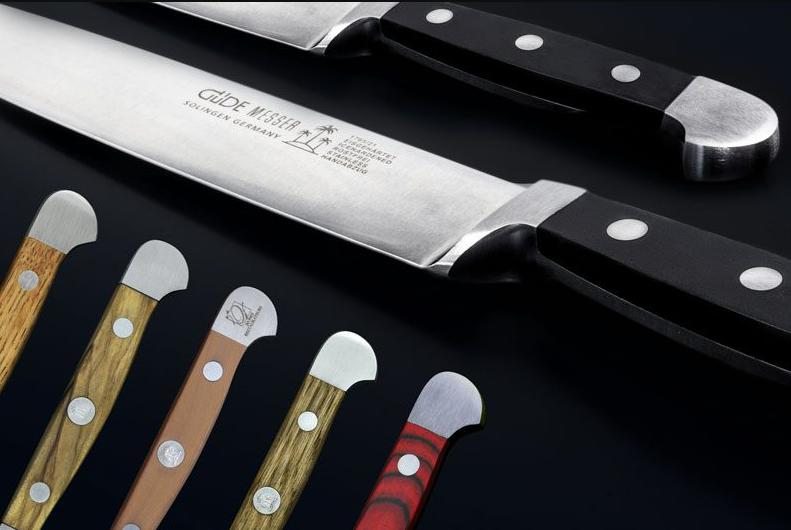Collapsible content
The Material of the Blade: Hard or Soft Steel
The blade material of knives has to meet a wide range of requirements, some of which are contradictory. It is therefore necessary to achieve an optimum between the various requirements. A knife steel should be hard, but not too hard, otherwise it would break. But it should also not be too soft, otherwise the knife would become dull too quickly due to wear. Therefore, the knives from Gude are made of a chrome-molybdenum-vanadium knife steel, which has an optimal hardness of about 57-58 HRc (Rockwell).
The Material of the Handle: Wooden Handles or Plastic Handles
Wood is a natural material. Its color and grain make a knife a real eye-catcher. But wood also shows its pleasant side when gripping a knife, as it feels warm and soft to the touch. However, handles made of wood are not dishwasher-safe, unlike handles made of plastic. Plastic handles from Gude are made of Hostaform and meet the requirements of the catering industry. They are easy to clean and dishwasher safe.
Forging: Drop Forging or Upset Forging
Drop forging ensures high material strength even under dynamic stresses. In drop forging, the entire forging blank is heated and deformed.
In contrast, in upsetting forging only a small part of the strip steel, usually the middle part, is heated and then deformed. This method is mostly used for reasons of production economy; the achievable mold material is very limited.
In drop forging, the shape is free from the tip of the blade to the end of the handle. A design language like that of SYNCHROS or THE KNIFE. is only possible in the drop forging process. That is why GÜDE remains true to this proven technology.
The Blade: Flexible or Rigid
Even a hard steel, such as Gude knife steel, can be very flexible when ground very thin. A flexible blade is particularly suitable for filleting fish by moving the blade back and forth between the skin and the fillet with a slight bend.
A rigid blade is torsional stiff and thus guarantees a more precise guiding of the knife and thus a more precise cut.
The front part of the SYNCHROS carving knife is ground thin so that the blade is flexible in this area. This makes the SYNCHROS carving knife equally suitable for filleting fish.
The Beading: Acute or Obtuse Beading Angle
Cutting is "physically" the driving of a wedge through a material to be cut. The more acute the angle of the wedge, i.e. the bevel angle, the better this works. The bevel is the knifemakers' term for the cutting edge, i.e. the sharply ground part of a knife. A sharp bevel angle makes a knife sharper than a dull bevel angle.
However, if the bevel angle is too acute, the bevel can break. Therefore, the knives from GÜDE have an optimal bevel angle of about 33 degrees. This angle guarantees sharpness and stability at the same time.
The Serrated Edge: Shaft or Separation
As early as the end of the 1930s, people at Gude were thinking about how best to design the teeth of a bread "saw". The result was the "Gude serrated edge", whose inventor is Franz Güde .
The special "Gude serration" has more aggressive teeth than conventional serrations. Both cutting ability and edge retention are increased by this special grind. And so the Franz Güde bread knife glides through even the hardest crusts.
The Bolster: Bolster or Double Bolster or no Bolster at all
The bolster is the thickening of the blade steel. The (front) bolster between the handle and the blade serves both as finger protection and balance weight.
An unmistakable feature of many series from Gude is the so-called double bolster. The second bolster at the end of the handle gives the knives a better balance. This guarantees the user pleasant and fatigue-free work.
THE KNIFE . and the knives from the SYNCHROS series deliberately do without the bolster. The seamless transition from handle to blade creates a completely new haptic and functional experience.
The Tang: Full Tang or no Tang
The tang is the part of the steel to which the handle of a knife is attached. If the tang goes from the blade to the end of the handle, it is called a full tang. The tang, as the name suggests, is stuck in the handle so that it is not visible.
The full tang, on the other hand, can be seen between the handle scales on knives from the Alpha series. On series such as SYNCHROS or Caminada the full tang is formed as a cross tang at the lower end of the handle.
The knives from Gude all have a full tang, as this provides a better balance of the weight. An exception is THE KNIFE. Since this knife is only used in the so-called overhand grip, the balance is automatically achieved by the grip position, so that the centre of gravity is inside the hand.
The Grip Posture: Standard Grip or Over-Grip
The "standard grip posture" is the position of the hand exactly around the handle of a knife, e.g. in the Alpha series between the front and rear bolsters.
To achieve better power transmission and more precise control, many professional and amateur chefs grip the knife further forward, so far forward that the thumb and index finger can grip the blade on the left and right. This grip position is called "overgrip".
THE KNIFE . is designed in such a way that it is automatically gripped in the "overhand grip". The SYNCHROS series gives the user the choice of how to grip the knife.
Discover More Knife Series
-
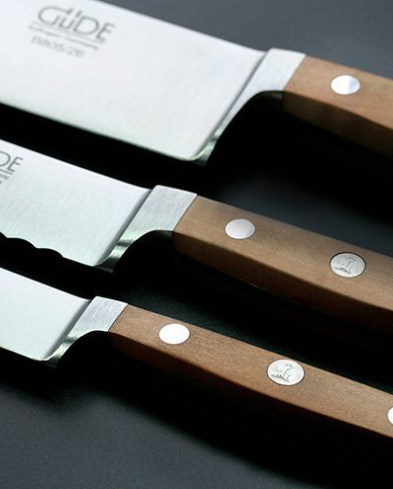
Alpha Pear Wood Handles
The Alpha Pear series was launched on the occasion of the admission...
-
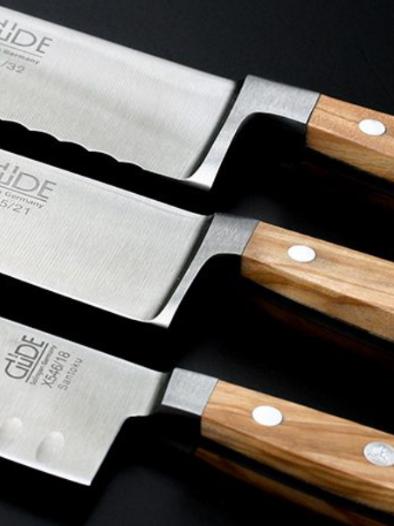
Alpha Olive
The blade of chrome-vanadium-molybdenum knife steel is hand-forged from one piece of...
